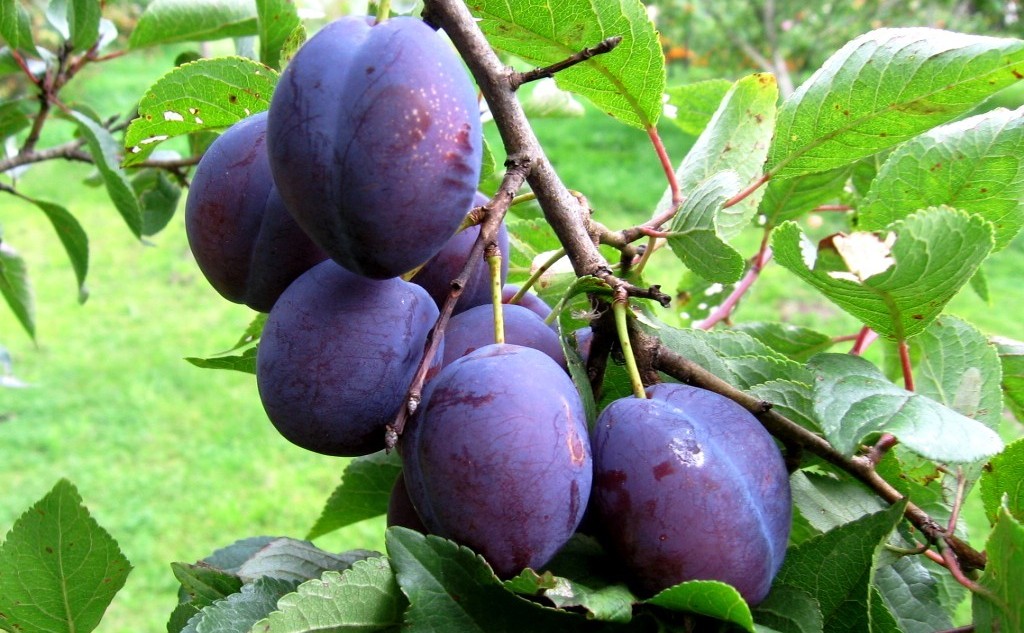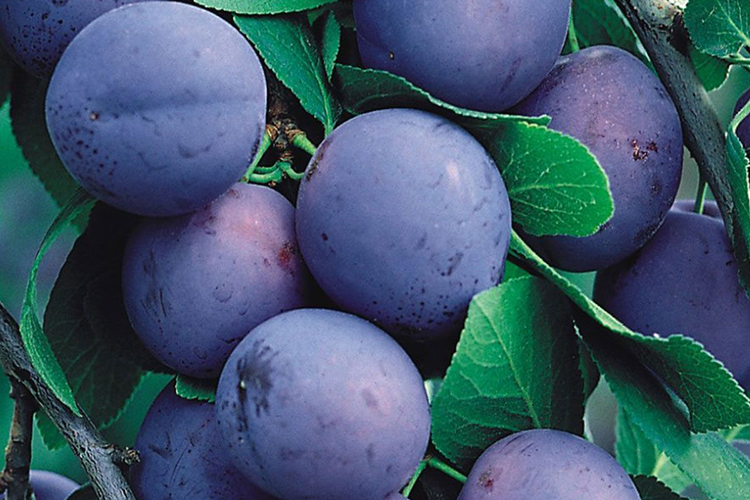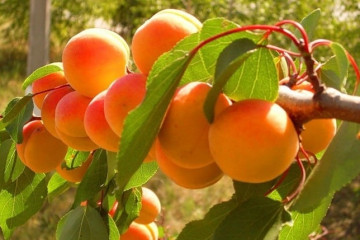The best plum varieties for the Moscow region, self-fertile and undersized
Content:
Of all the stone fruit crops, plums are considered the most common and popular for cultivation. Such trees are unpretentious to care for, and therefore are in demand among summer residents and ordinary amateurs. However, in connection with the climate of the Moscow region, which does not allow the cultivation of many varieties of plums, the question may arise of how to quickly determine the choice when buying seedlings.
Climatic features of the region
This is not to say that the climate of the Moscow region is too harsh, but when choosing a suitable variety, first of all, you should pay attention to its adaptation to severe cold or spring frosts.

Despite the fact that for the most part different varieties of plums have similar disadvantages, there are also almost ideal breeds.
On average, one month of summer accounts for about 75 mm of precipitation, excluding periods when severe droughts occur. Snow cover is observed here from late October to mid-April (there were cases when the snow disappeared already in March). In winter, a cover of about 20-25 cm high is formed from the snow. The sun shines here exactly half the days a year.
In the general case, we can safely say that a self-fertile or self-pollinating plum is better suited for the Moscow region. There are a lot of such varieties and there are plenty to choose from.
When the plum blooms in the suburbs
The plant begins to bloom no later than the end of April. Some varieties of fruit trees bloom earlier, others much later.
The timing depends not only on the variety, the weather in a particular year plays an equally important role.
It is optimal to select such plums, the flowering of which begins as early as mid-May. This guarantees the grower large yields and protection from severe frosts.
The varieties most suitable for growing in the Moscow region
The region, in spite of the temperate climate, is "famous" for its return frosts. Therefore, the variety chosen by the gardener must be winter-hardy or simply resistant to minor temperature changes.
In order for the trees to develop calmly and healthy, you need to stop at low or medium-sized trees. For example, a large-fruited plum for the Moscow region of the Zarechnaya early variety is ideal for planting in small gardens. It is important for a specialist to determine in advance what he expects from planting a given plant: high yield or modest but regular fruiting.
Oryol dream
Quite low drain, which can reach a maximum of 2.5 meters in height. Bears fruit early and blooms in April. The fruits ripen with juicy red-brown drupes. There is no need for artificial pollination.
Zarechnaya early
Medium-sized tree with juicy, amber, sour-sweet fruits. Due to the fact that the variety belongs to the superearly, the harvest can be harvested at the end of July. Winter hardy (above average). Additional pollination is required.
Blue gift
Dark plum, up to 3 meters high.May produce small bluish drupes in mid-August. Self-pollinated.
Kolkhoz renklode
Low-growing plant, medium-late ripening. Fruiting focuses on both twig bouquets and annual growths. Small sweet yellow fruits ripen.
Blue bird
Experts give this variety 4.6 points in terms of organoleptic indicators and taste. Blue oval drupes are pollinated by Caucasian Hungarian.
Hungarian Korneevskaya
Purple-brown fruits. It begins to bloom in early May, and ripens by early September, depending on the year of planting. Abundant productivity.
Red ball
A dwarf tree with a maximum height of 2.5 meters. The fruits are large with a red skin, which is slightly bluish.
Renclaude Leah
Small yellowish-green fruits with rather juicy pulp. Medium-sized tree with an oval-round crown. Bears fruit exclusively on its own.
Vitebsk late
Panicled crown, undersized plant. Dark red fruits with a blue-violet tint. If the plum is ripe, the stone is easily separated from the pulp.
Egg blue
Can bear fruit without participating in the ripening process of pollinators. Tall and grows about 6 meters in length. The fruits are harvested in mid-August.
Early ripening red
The description of this variety should start with the mention that the plant ripens only by September. As a result, the gardener gets raspberry-purple fruits. Self-fertility is absent.
Anna Shpet
The most popular type of plum. Pollinated by green Renklode, it is completely unpretentious to any growing conditions. Purple fruits with a sweetish taste.
Early comet
Cherry plum with large berries. Burgundy with pink juicy pulp. Winter hardy and fertile.
Yakhontova
A fast-growing and vigorous tree ideally suited to the Moscow climate. Round fruits ripen by the beginning of August (it is possible to harvest earlier).
The president
Produces large purple berries. Experts rate the taste of this fruit at 4.6 points.
Golden ball
Belongs to the Rosaceae family. Golden-yellow fruit with orange flesh and bone that can easily come off the flesh. High taste. Ripening period - late July-early August.
Smolinka
Medium ripening homemade plum. Two-flowered inflorescences produce dark purple fruits with a sweet taste and no extra strokes.
Yellow honey
Light berries and memorable flavoring features. The variety ripens at the end of July, sometimes at the end of June. The fruits are used for baking, they are well tolerated in freezers.
Volga beauty
Drupes of crimson-blue color. Pollinated by Skorospelkoy.
Starting
Early medium-sized plant. When ripe, the fruits do not fall off. Well resists various types of diseases.
Kantemirovka
Blue berries. The flowering period is the 2nd decade of May, ripening closer to the beginning of August. Possible diseases: rust, spotting and powdery mildew.
Crooman
Fruit tasting score - 4.3 points out of 5. Dark red berries. Medium-sized tree with a round crown.
Sukhanovskaya
Compact crown with medium leafiness. Ripe fruit of light green color. It blooms from late April to 15 May and bears fruit by 20 August.
Bolkhovchanka
Average vigor. Egg-shaped burgundy-green fruits. Self-fertile variety with high frost resistance.
Based on the above information, the best varieties of plums for the Moscow region are very different and gardeners have a wide choice.
In addition to the above varieties of plums, there are hybrids that cost gardeners a little more expensive than ordinary ones and bear fruit less often, but are more resistant to frost and disease.
How many years does a plum bear fruit in the Moscow region
In the case when a specialist observes all the conditions for growing a tree, the plum begins to bear fruit at 3-4 years of age. Depending on the area in which this plant is cultivated, it can bear fruit for more than 20 years.
How to plant and grow plums in the suburbs
Planting and caring for a plum in the Moscow region presupposes compliance with a number of rules. The main ones are:
- The best time to plant plum trees is without a doubt spring.
- The landing is carried out in early April, in the first days of it.
- When choosing a good side, the plant is planted closer to the south and sandy loam soils. The seedling must have strong, deep roots.
- The planting hole must be done in the fall so that the place has time to prepare.
Further care is not too difficult: regularly water, loosen, spray. In the fall, it is imperative to remove fallen fruits and foliage from the site, and cover the trunk from pests.

Plum trees must be resistant to extreme cold weather, including frosty winters and unexpected spring frosts.
Recommendations for the care of plums in the Moscow region
With normal rainfall, the tree should be watered at least once a month. With the arrival of spring, the soil needs to be fed with nitrogen fertilizers. In order for the plum to develop calmly, it is periodically pruned. Pruning should be done before budding.
There are dozens or even hundreds of varieties with the necessary characteristics. Gardeners of the Moscow region can study their characteristics in more detail and plant a couple of varieties on the site in order to get a tasty and healthy harvest.


















